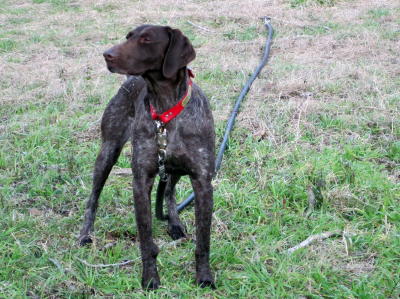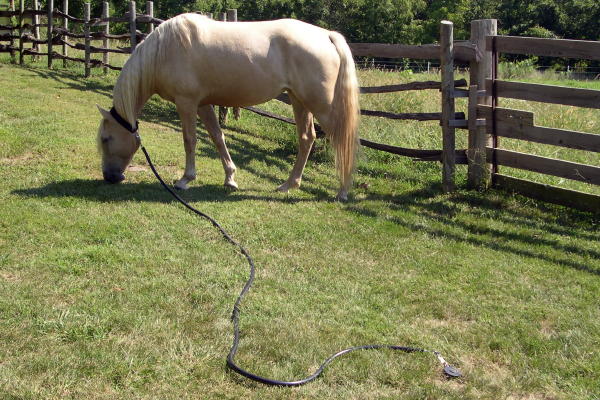Welcome to Lazy Liz’s Horse Picket System


Works well for tangle free dog stakeout
Lazy Liz’s Picket Kit- offers you a safer means of tethering horses in areas where corrals are not available. Waking up to find that your horses have escaped over night to who knows where can ruin anyone’s day on the trail. Liz’s innovative line of picketing products provides a practical solution to this problem. Trail riders, field trial participants, and horse and mule backcountry packers who need to graze their horses safely in areas where there are no corrals can depend on the Lazy Liz Picket System. Her system helps to prevent a calamity such as a halter tied horse twisting their neck as they try to breakaway from a hitching post. Her safety stake helps to eliminate the worry that a horse will cut themselves by rolling over on a sharp tie stake. Her use of a panic snap-clip in combination with a Bull Snap on one end of the tether enables you to make a quick release of a horse involved in a wreck using one hand. The Lazy Liz family of products is environmentally sensitive, horse friendly, and easy to use. Her picket stake system is especially useful in open, treeless areas and in environmentally sensitive areas where tethering to trees might lead to bark or root damage.
SAFETY CAUTION and DISCLAIMER
Much care has gone into the design and manufacture of the products in Lazy Liz’s Picket Kit. However, this is a restraint system and some horses can panic when restrained no matter how much preparation you endeavor to make. The use of these products by their nature, and the remote nature of conditions where they are often employed, does expose your horse to risk of injury or death. These risks include, but are not limited to, entanglement in the tether which might cause your horse to fall and be injured. So, use these products at your own risk. Desensitizing your horse’s feet to contact with ropes or other objects, and training your horse to hobble before going on the trail is beneficial to minimizing the inherent risk of these products. The training process should not be hurried. Take all the time necessary until your horse becomes relaxed and comfortable with being tied to a ground stake.
A SAFER WAY TO PULL A STAKE OUT OF THE GROUND
Pulling a stake that is driven deeply into a tight soil can be difficult and can even lead to back injuries. This method has worked well for me in the past and it may work for you. But, try it at your own risk.
Attach a vice grip pliers to the stake and rotate the stake while pouring water on its shaft. A couple of turns will do. Then take a rope and tie one end to the stake with a bowline knot or similar non slip knot that can be untied easily when the job is done. Then as though starting to sit in a chair located directly over the stake, bend your knees and lower your rear end almost to the imaginary chair seat. You are doing what is known in athletic training circles as half-squat position. Now, wrap the body of the rope around your waist for one complete turn and hold the remainder of the rope’s tail tightly to your belly button. Stand up straight. The stake should rise two inches or so. This technique puts the lifting forces onto your legs. Since your legs are much stronger than your arms, the stake should pull easily without putting strain on your back. Squat over the stake again, and slide the rope around you until it is tight, then stand once more. Repeat the process until the stake is clear of the ground.
A FEW SAFTEY TIPS
1. Be sure that the collar is located at the narrowest part of the horses neck. The narrowest area is found directly behind the horses ears. Be sure that the collar is buckled snugly.This prevents the horse from sliping their collar.
2. Drive the stake all the way down into the ground. The cap should be within one and one half inches of the ground. This allows just enough room for the swivel to rotate.Driving the stake down completely makes it most unlikely that a horse can hurt themself by rolling over on a stake.
3. When staking out two horses, be sure that only their noses touch. That way the horses can not cross paths and become entangled.
4. Before staking them in an area that has no fences, train your horse to tether at home in the round pen or corral.







